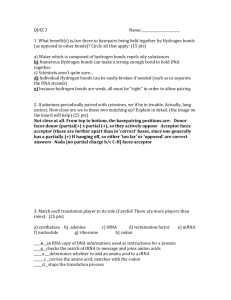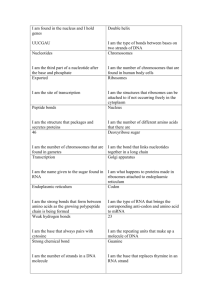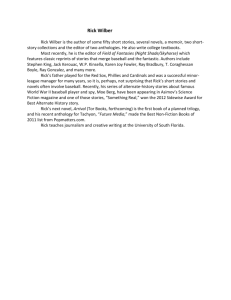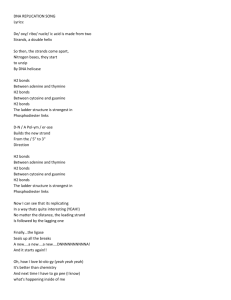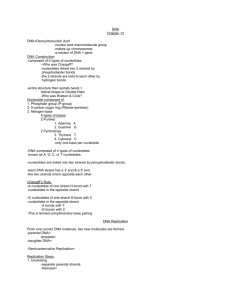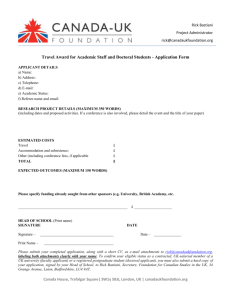Nucleotides, The Building Blocks of Nucleic Acids, Have Three Parts
advertisement
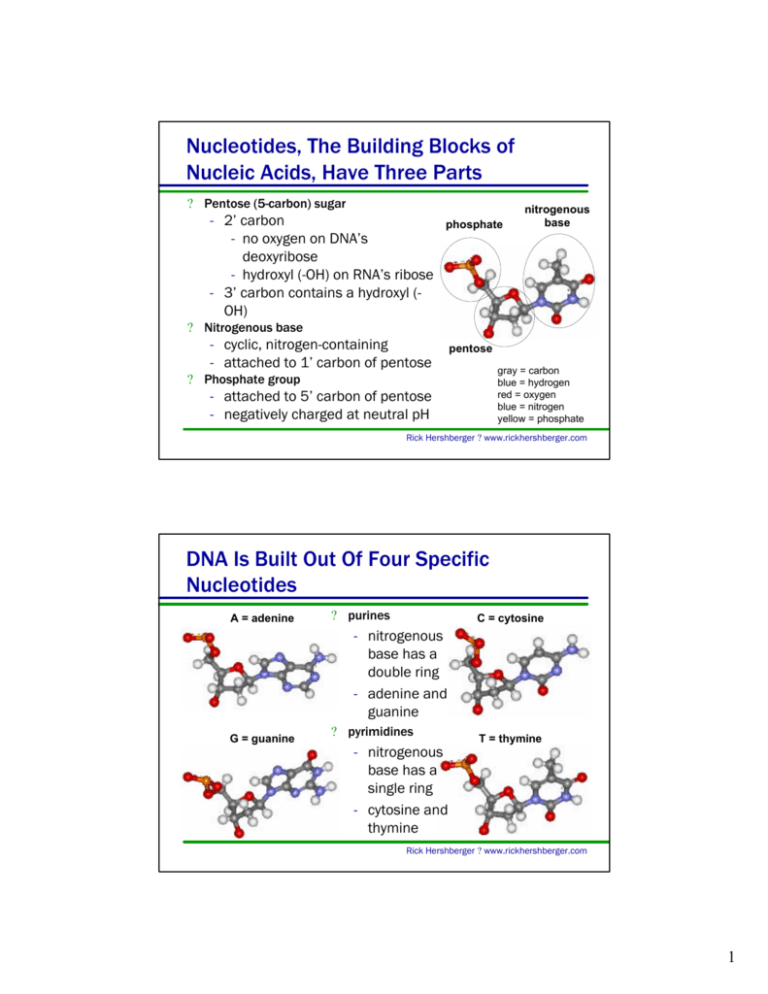
Nucleotides, The Building Blocks of Nucleic Acids, Have Three Parts ? Pentose (5-carbon) sugar - 2’ carbon - no oxygen on DNA’s deoxyribose - hydroxyl (-OH) on RNA’s ribose - 3’ carbon contains a hydroxyl (OH) phosphate nitrogenous base ? Nitrogenous base - cyclic, nitrogen-containing - attached to 1’ carbon of pentose pentose gray = carbon blue = hydrogen red = oxygen blue = nitrogen yellow = phosphate ? Phosphate group - attached to 5’ carbon of pentose - negatively charged at neutral pH Rick Hershberger ? www.rickhershberger.com DNA Is Built Out Of Four Specific Nucleotides A = adenine ? purines C = cytosine - nitrogenous base has a double ring - adenine and guanine G = guanine ? pyrimidines - nitrogenous base has a single ring - cytosine and thymine T = thymine Rick Hershberger ? www.rickhershberger.com 1 Nucleic Acids are Polymeric Strands ? Polynucleotides are polymers of nucleotides connected by phosphodiester bonds. 5’ phosphate - Phosphate group at 5’ end of one sugar reacts with the hydroxyl group at the 3’ end of another sugar. ? Forms a sugarphosphate backbone phosphodiester bonds 3’ hydroxyl Rick Hershberger ? www.rickhershberger.com Dehydration Synthesis Reactions Release Water Molecules ? Synthesis involves removing the OH- group from one subunit and a H+ from another. - Called dehydration synthesis or condensation reaction. ? H+ combines with OH- to reform H2O (water). X O H Y O H H X Y H Rick Hershberger ? www.rickhershberger.com 2 Hydrolysis Reactions Require Water to Break Linkages. ? Hydrolysis introduces water at the linkage between subunits. X O H Y O H H - The polymer is "hydrolyzed". ? One subunit gains a H+, and the other subunit gains the OH-. X Y H Rick Hershberger ? www.rickhershberger.com The Atoms within Molecules are Connected by Chemical Bonds. ? Ionic Bonds - One atom loses an electron, one atom gains an electron, then the two opposite-charged ions attract. ? Covalent Bonds - Atoms are held together by sharing electrons both need to fill up their outer orbital of electrons. ? Hydrogen Bonds - A hydrogen atom covalently attached to one atom is weakly drawn toward another atom. Rick Hershberger ? www.rickhershberger.com 3 Strands Are Held Together By Hydrogen Bonds Between Base Pairs T ? Nitrogenous bases on opposite strands form specific base pairs. G - Hydrogen bonds are weak and easily broken and reformed. ? Watson-Crick base pairing rules A - A binds to T through two hydrogen bonds. - C binds to G through three hydrogen bonds. C Rick Hershberger ? www.rickhershberger.com The Two Strands of a DNA Molecule are Complementary 5’ AGGCTGAATCGATACGT 3’ ||||||||||||||||| 3’ TCCGACTTAGCTATGCA 5’ ? Watson-Crick base pairing rules require that the nucleotide sequences of opposite strands be complementary. ? The sequence of one strand determines the sequence of the opposite strand. - This allows one strand to serve as a template for accurately building an opposite strand. Rick Hershberger ? www.rickhershberger.com 4 DNA is a Double Helix of Two Antiparallel Polynucleotide Strands 3’ 5’ 5’ ? Two strands wind around each other. ? Strands are held together by hydrogen bonds between nitrogenous bases. ? Bases are inside. ? Sugar-phosphate backbones are 3’ outside. Rick Hershberger ? www.rickhershberger.com The Cyclic Rings Of The Bases Are Stacked Within The Double Helix ? Nitrogenous bases align themselves parallel to each other. Rick Hershberger ? www.rickhershberger.com 5 DNA is ... ? two polynucleotide strands ? with complementary sequences of nucleotides ? in a double helix ? in antiparallel orientation ? held together by weak hydrogen bonds Rick Hershberger ? www.rickhershberger.com Watson and Crick, Nature, 2 April 1953 Molecular Structure Of Nucleic Acids: A Structure for Deoxyribose Nucleic Acid ? It has not escaped our notice that the specific pairing we have postulated immediately suggests a possible copying mechanism for the genetic material. Rick Hershberger ? www.rickhershberger.com 6 Enzymatic Requirements of DNA Polymerase and its Constraints on DNA Replication ? DNA polymerase only adds a nucleotide that is complementary, forming a correct Watson-Crick base pair. - Requires a template strand. ? DNA polymerase only adds a nucleotide onto the 3’ end of a strand. - Requires a deoxynucleotide triphosphate (dNTP) as a substrate. ? DNA polymerase only adds a nucleotide onto the 3’ end of a base that is correctly based-paired. - Requires a primer. Rick Hershberger ? www.rickhershberger.com 7


